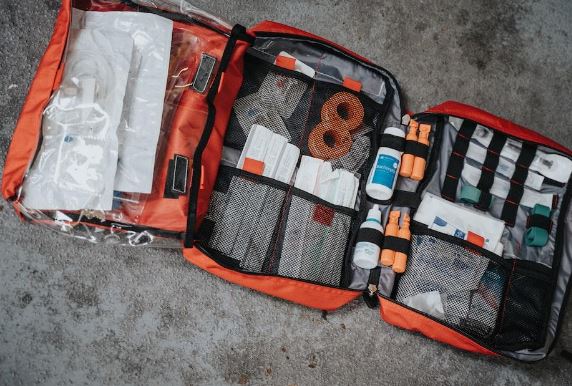
Get CPR training for your team!
If you have any questions feel free to email us at info@emccprtraining.com
CONTACT ONE OF OUR EXPERTS HERE

Last Updated on April 27, 2023 by CPR Training
There are many dangers of winter that pose a hazards to your health if proper precautions are not taken. Hypothermia, frostbite, and slips and falls due to icy conditions are some potential risks.
It is important to dress warmly when going outdoors in cold weather. Wear layers of clothing that will trap body heat, including mittens or gloves, hats that cover your ears, waterproof boots or shoes with nonslip soles, and scarves to protect your face from the wind.
In addition, staying dry during winter activities is important, as wet clothes can increase the chances of hypothermia or frostbite.
Ensure you have adequate supplies like a flashlight and blankets if you get stranded while traveling in wintery conditions.
In the following blog, we will discuss how to avoid winter dangers. Let’s start with a better understanding.
The common cold and the flu are dangers of winter. They are respiratory illnesses, but have different symptoms and require different treatments.
The common cold is milder than the flu, but it can still cause serious illness in children and those with weakened immune systems. Common cold symptoms include a runny nose, sore throat, sneezing, coughing, headache, and tiredness. The flu symptoms are more severe than a cold and last longer. Flu symptoms include muscle aches, fever, chills, cough, congestion, fatigue, headaches, and sometimes vomiting or diarrhea.
It is important to take extra precautions during the winter months to prevent colds or flu. Here are a few first aid tips to help protect yourself from catching a cold or flu:
Frostbite is a condition that happens when the skin and underlying tissues are exposed to cold temperatures.
It results in decreased blood flow, which can cause permanent tissue damage or even death if left untreated.
Signs of frostbite include numbness, tingling sensations, white or grayish-yellow skin, and hard or waxy-looking skin.
How to Treat Frostbite with First Aid
Treatment for frostbite depends on the condition of the injury. It may include rewarming the affected area gradually with warm (not hot) water or skin-to-skin contact. Plus you should wrap the area in sterile bandages, ensuring that fingers and toes are separated with gauze, removing jewelry from the affected areas, and taking pain relievers to reduce discomfort. In severe cases, surgical repair may be necessary. If you think you have frostbite, it is important to seek medical attention immediately, as serious complications can occur if not treated promptly.
When exposed to cold temperatures, it is important to take the necessary precautions to avoid frostbite. There are a few measures that one can take to protect themselves.
Dress appropriately for the weather conditions and activity level. Make sure all body parts are well-insulated when going outside, and wearing multiple layers will help trap more heat against your skin.
Keep any exposed areas covered with warm fabrics such as wool or fleece hats, gloves, and scarves. If you’re planning on being active outdoors for extended periods, replace wet clothing with dry items as soon as possible.
Firstly, you need to know about hypothermia, as another serious danger in winter. Let’s discuss this in detail.
Hypothermia is a dangerous condition that occurs when the body cannot maintain its normal temperature and drops below 95°F. It can occur in any season or climate, but is most common during cold weather. Symptoms of hypothermia include shivering, exhaustion, confusion, slow breathing, and heart rate. If you don’t get treatment, it can create health complications such as organ failure. Knowing the signs and symptoms of hypothermia can help you identify and treat it before it worsens.
Hypothermia can have dangerous consequences and, in some cases, even be fatal. But first aid can help treat it from worsening and potentially save lives.
Here are a few ways you can provide first aid for someone who may be suffering from hypothermia:
Winter increases the risk of slips and falls due to icy conditions, which can cause serious injury. To stay safe, wear shoes or boots with good tread, take shorter steps to reduce your chances of slipping, and use handrails for support when walking on icy surfaces.
Be mindful of wet floors in buildings, as they also increase the risk of slipping. Make sure any walkways in your home or office are free from debris and other hazards. This includes ensuring carpets, rugs or mats are not bunched up where people may walk on them. Replace any carpet with non-slip flooring material.
Always wear shoes with nonslip soles when walking around wet areas such as bathrooms and kitchens. Avoid wearing high-heeled shoes if you must walk on slippery surfaces..
If you slip and fall, seek medical attention as soon as possible. You can stay safe throughout the season with these simple precautions and remaining alert around the hazards posed by winter weather.
Prepare your workplace to be safer by learning lifesaving skills with our AED and CPR classes. Also, be better equipped to respond during unexpected emergencies. Our EMC CPR & Safety Training experts will prepare your staff to be well prepared to handle many emergencies. Click here to learn more about our CPR Story.
Get CPR training for your team!
If you have any questions feel free to email us at info@emccprtraining.com
CONTACT ONE OF OUR EXPERTS HERE